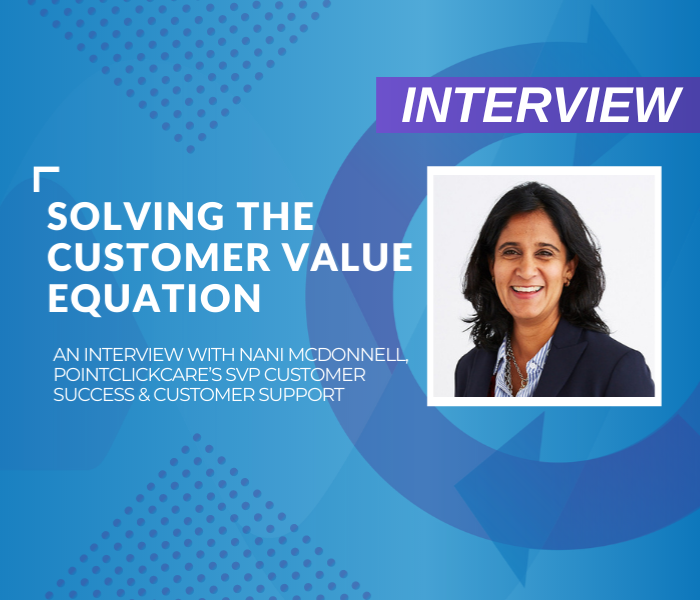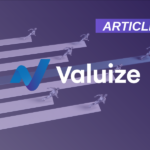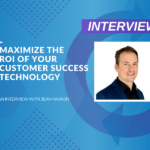Is Your Customer Success Strategy Built To Scale Customer Value?
The rush to become a premier digital-first organization has seen many scramble to build a robust digital engagement model. In the race to become the first and best, some organizations have forgotten to lay a solid foundation that not only ensures the current success of the digital-led approach, but also their ability to scale. If your organization’s engagement model doesn’t start with a clear and universal understanding of the who, what and how of the customer value equation, you have a tremendous opportunity to achieve best-in-class Net Dollar Retention (NDR).
To evolve your approach to delivering sustainable and scalable customer value, Valuize’s Founder & CEO, Ross Fulton, spoke with seasoned expert Nani McDonnell, SVP Customer Success & Customer Support at PointClickCare. Nani is a trailblazer in the Customer Success space, having pioneered customer value and outcomes in the healthcare industry for over 20 years. In this interview, Nani delves into the building blocks of an impactful digital-led approach and shares her expertise on how you can scale your customer value model to drive unparalleled revenue retention and expansion.
Q: When it comes to B2B technology, you can’t successfully scale without a clear definition of what value really means to your customers and adopting this as a universal concept in your organization. What do you think is the foundation of delivering customer value at scale?
A: “As we started to dive into this at PointClickCare, we discovered that many organizations are just dipping their toes in this concept of delivering customer value at scale. While the “what” and “how” of the customer value equation are important, I think understanding the “who” is critical. First and foremost, organizations need to understand who their clients are and their demographic. A clear understanding of the customer is what drives the what and the how of delivering customer value. This is especially true as these organizations scale and grow; driving customer value is more straightforward when you’ve got a 1:10 client ratio but once your ratios increase to 1:300 or 1:450, knowing how your customers are using your product and understanding their behavior becomes vital. Equipped with this insight, you can properly assess Time-to-Value for your product and know exactly when you need to reach out to your customers across their journey. Closely tied to this is your product design – you need to build your product around your customer and ensure that your strategy to deliver customer value is built into your operational ecosystem. Once you can instrument this successfully, the rest becomes simple as long as you have the right technology to support your strategy.”
Q: A really important aspect of delivering value at scale is instrumenting value within the product. With product engineering, you can start to leverage standardization at scale, baking value engineering and value realization into that. Is there a united definition of what value is for a customer adopting PointClickCare solutions?
A: “At PointClickCare, the process is more bespoke and hands-on, especially with our enterprise clients. We always have personal conversations with each customer so we can clearly and thoroughly understand the value that they’re trying to achieve. Once we have this baseline, we can instrument their experience to ensure that they’re getting the value that they want from our products. As we build out our product, we are always thinking about the workflows that will allow our customers to achieve that value at scale. That is essentially what Value Engineering is – it’s the Product team engineering the value, and Customer Success being able to deliver it repeatedly and continue the ongoing support at scale as well.”
Q: Something you have a lot of experience in is Product-Led Adoption, a nod to Product-Led Growth and the explosion of the self-sufficient buying experience. In the world of adoption and Customer Success, it essentially means using your product interface to prescribe to the customer; here’s what you should do next to ensure that you’re using this product in such a way that you will achieve the next piece of value. Can you share your insights on this subject?
A: “One thing that immediately comes to mind is how our Product team at PPC did a phenomenal job at the inception of COVID. In response to the pandemic, they built an infection prevention control product that our clients were able to log into and sign themselves up for, being able to do everything they needed without ever having to pick up the phone to contact our support team. One of the learnings from this project, and something we continue to do because it’s an important aspect of not just healthcare but all SaaS organizations, is instrumenting the back-end to ensure that our systems support the journey that we want our customers to have. For example, when a customer signs up, does someone pick up the phone and call the customer? Does the customer receive training material? As an organization, are we watching adoption at certain points in time? These are all crucial elements of Product-Led Adoption. In a nutshell, PLA ensures that the systems behind the scenes are facilitating the delivery of the customer journey that you prescribed and the value that the product is built to achieve. For this to happen successfully, you need to understand your product usage, as well as what best-in-class usage looks like, and what happens if your customers slip from this best-in-class status. Do you want to pick up the phone and call when this occurs, or can you instrument automatic email where they can sign up and potentially meet with somebody if they feel like they need to? If they decide to cancel, assuming that they can sign up via the product, they should also be able to cancel in the product. Is it at that point that you initiate personal outreach so that you can get a better understanding of their decision and see if they weren’t getting the value they expected? How do you close that gap for customers? These are the questions you need to answer in order to determine what the right Product-Led Adoption strategy is to solve the customer value equation in your organization.”
Q: A constant debate in B2B technology companies is this notion of a human-led versus product-led approach. Any advice you’d give a leader trying to reconcile these approaches and strike the right balance in their customer lifecycle?
A: “I think it’s really important to understand your business and your product. There are some products that are really simple and others that are very complex. At PPC, our product is very wide and very deep. For us, Cost of Acquisition starts to become really important. What we’ve decided to do, even in our digital touch model, is have consultants monitor implementation and reach out at certain personal touch points because it’s important for us to ensure that anyone who is using our product understands the behind-the-scenes configuration and knows what to get from it. We have implemented a number of digital milestones and as we watch adoption, if we’re not seeing what we want, then we do have a consultant that will pick up the phone and reach out.
As an organization, we decided that it’s really important for us to ensure that the second someone decides they want to adopt one of our products, they are going to realize that value within a certain amount of time. The time will differ depending on the product, but we know what best practice looks like from a Time-to-Value perspective and we want to ensure that the customer is getting value, regardless of whether they are part of our human-led program or product-led one.
Ultimately, the 90/10 rule applies here because best practice covers 90% of your customers. To address the customer value equation, build an experience focused on driving value for the 90% because there are always going to be folks that fall out. You just need to ensure that you’ve got a safety net for those that fall out.”
Q: There’s a reason we’re talking about delivering Value-Based Outcomes at scale, and not delivering Value-Based Outcomes for everyone because that’s not an achievable target. Find a strategy that addresses the 90% and have a plan for the 10%. What advice do you have for leaders that are trying to enable this in their organization?
A: “Sales teams can be really important here. If during the course of the selling motion, they realize that the client they’re speaking to is recognizing value different than the 90%, Sales needs to ensure that there is a way to address that as the customer moves along the customer journey. As Customer Success, having a tight-knit partnership with Sales is critical to ensuring that Sales is asking the right questions to understand what the client wants and that there is a way to instrument that throughout their implementation, CSM and Support journey as well. That’s really the crux of the customer value equation.”
Q: We can’t talk about digital scale instrumentation or Product-Led Adoption without talking about data. Where do you think the industry stands today in regards to data and where do you see it going next?
A: “There’s a continuous love-hate relationship with data. I feel like everyone is talking about data and it’s somewhat ubiquitous. But, what many leaders are asking themselves now is: are we deriving the insights that we need from our data? At PointClickCare, and within many B2B organizations, we currently have so much data in our hands that collecting this data just for the sake of it isn’t helpful or insightful. We’re constantly working with our teams to make the most of our data. There’s a guiding question we ask ourselves: what action can we take from this data? If we can’t take action, then let’s move on to the next piece of insight that we have so that we’re constantly looking to move forward as opposed to just getting mired and stuck in data that isn’t providing actionable insight.”
Build A Strong Value Foundation To Solve The Customer Value Equation
To surmount the obstacles that come with shifting to a digital-led approach, you need to start with a strong foundation that addresses the customer value equation. A clear vision for the who, what and how of customer value realization that can be standardized and implemented across your organization determines your ability to successfully scale your business and drive best-in-class Net Dollar Retention.
Listen to Nani’s full interview on the Customer Valuecast podcast for more insights into how you can successfully deliver measurable customer value at scale.






